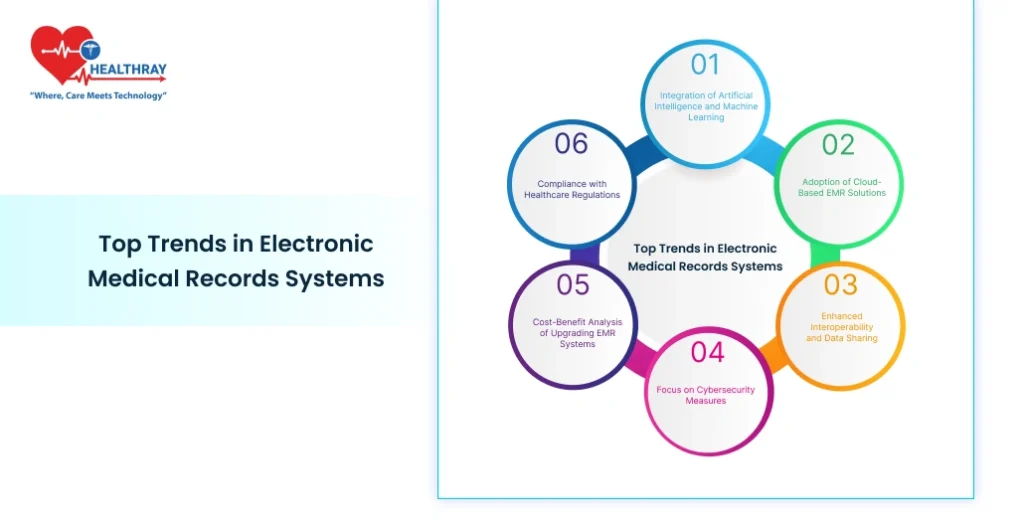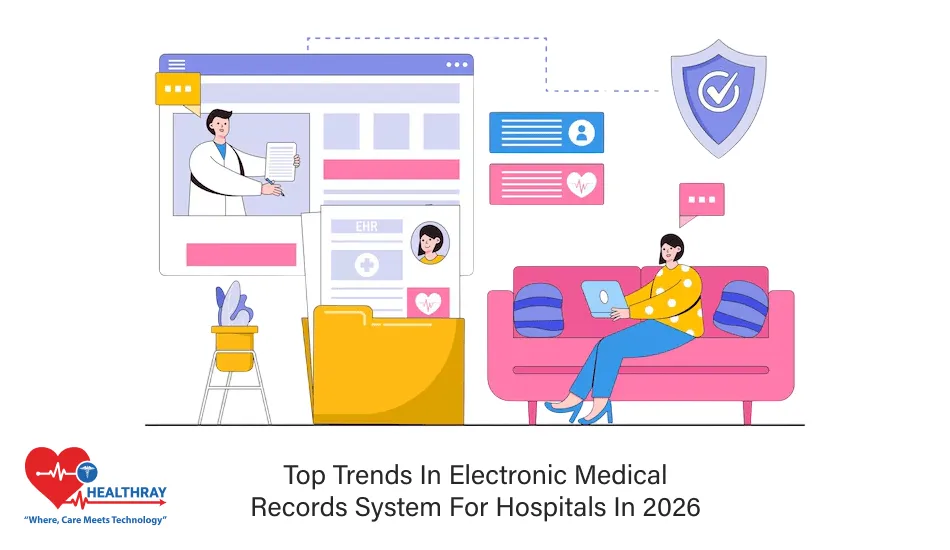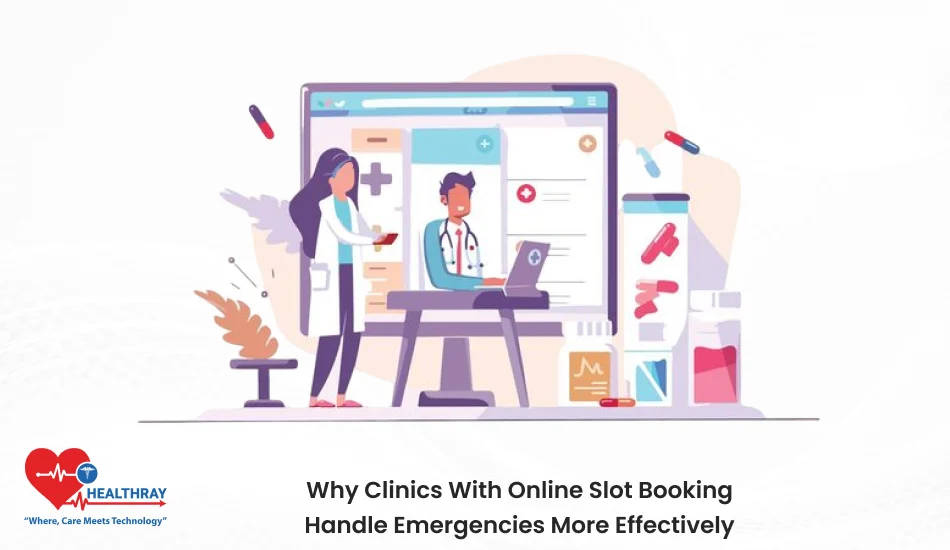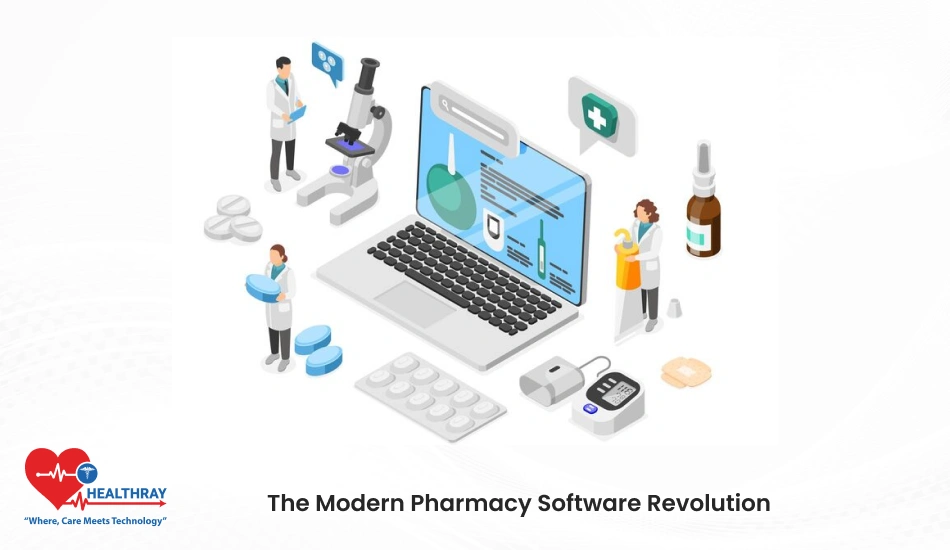Healthcare is moving at an incredibly fast pace, and the electronic medical record system is at the heart of it all. An updated, efficient EMR system becomes very necessary for a hospital instead of a matter of convenience. These systems can do much more than just store patient records: they improve patient outcomes dramatically, smoothen daily operations, and create a seamless experience for both patients and healthcare professionals.
Approaching 2025, new technologies are now rewriting the rules of how EMR systems function. Artificial intelligence, cloud solutions, and increased security are features one would find standard in any of today’s modern EMR systems. This change means that hospitals can manage their patient data more effectively, make far better decisions, and comply with increasingly stringent regulatory requirements.
The following post highlights the top trends likely to shape the design and functionality of the EMR system in 2025, offering perspectives on how technology leaders and health professionals can leverage this progress to stay ahead in the ever-growing competitive industry. Whether you’re a hospital administrator, a healthcare provider, or a tech innovator within health tech, being cognizant of these trends allows you to make the most appropriate decisions for your organization.
Top Trends in Electronic Medical Records Systems

Integration of Artificial Intelligence and Machine Learning
Artificial intelligence and machine learning take precedence for state-of-the-art EMR systems. Equipped with advanced analytics, it helps providers make quicker and more accurate decisions with greater insight. Artificial intelligence can process vast amounts of data concerning a patient within seconds, which would take an incredibly long time for any human mind.
Machine learning brings predictive capabilities in such a way that patient needs are anticipated, risk factors are identified, and even preventive care is suggested.
One field in which AI and ML are now changing the systems in the EMR is diagnostic support. For example, AI can search for patterns in medical records and flag symptoms and histories that would most likely indicate particular conditions.
Support like this helps doctors zero in on critical information without having to sift through piles of data for quicker diagnoses and more effective treatment plans.
Still, advanced features of AI-driven EMRs also contribute to improving clinical workflows. For example, automated data entry reduces administrative tasks, freeing up healthcare professionals to spend more time with patients.
As the technology continues to evolve, future EMR systems are likely to have even more interactive features, probably allowing them to easily communicate with a variety of diagnostic tools and devices. Such integration could allow top-rated electronic medical record systems to update the data in real time, thereby helping health professionals provide timely care.
With the exciting shift brought about by the rise of AI and ML in EMRs, a number of considerations arise regarding data privacy and system security. These concerns will have to be balanced against the need for advanced functionality if the EMR systems are to support healthcare providers and patients alike effectively.
Adoption of Cloud-Based EMR Solutions
The approach toward patient information in hospitals is being transformed with the cloud-based EMR solution. Cloud-based EMRs provide flexibility and access that has not been offered by traditional on-site systems, thus helping healthcare providers enormously. Cloud technology enables authorized users to access information about patients from any secure device, facilitating more coordinated care when providers are not in one setting.
The cloud-based EMR system reduces costs involved in infrastructure and maintenance for hospitals. The cost of updates, storage, and cybersecurity measures is usually taken care of by the cloud provider, requiring very minimal involvement from the healthcare institution in terms of managing those details on their own. This can reduce upfront costs and save money on ongoing IT support.
Other benefits of cloud-based EMRs are related to scalability. They can easily expand to meet new demands brought about by growth in the hospitals or increased volume of patients. This adaptability ensures that data management remains smooth during peak times or periods with a high flow of patients.
But the very process of moving data to the cloud requires giving equal importance to data security and regulatory compliance. A cloud service provider has to be compliant with all healthcare standards since patient information is very sensitive and bound by stringent regulations. While leveraging the benefits of cloud-based EMR, a hospital needs to find a trustworthy cloud service provider and put in place stringent measures that keep patient data secured.
Improving Interoperability and Data Sharing
In short, interoperability in the use of the EMR system means that diverse healthcare service providers and systems can share and make use of patient data without any obstacles. To the hospitals, that ability is a game-changer that permits coordinated care across various departments, specialists, and even external healthcare facilities.
The interoperable EMR system can make a difference. For example, if patient records are accessible across facilities, it would become easy for doctors to review past treatments, test results, and medications quickly, hence make informed decisions in less time with more context; this reduces redundancy, minimizes errors, and ensures that patients receive consistent care no matter where they are treated.
In the last few years, various standards and protocols have cropped up to manage this exchange of information. For example, one common framework in which patient data is shared is through a FHIR protocol. By putting in place standards and protocols such as FHIR, EMR systems can “talk” to one another; hence, there is streamlined data flow across different platforms.
Of course, where data sharing is concerned, powerful privacy protections go hand in glove. Any hospital seeking to utilize interoperable EMRs will have to encrypt patient data so that only authorized users access it. This trade-off between accessibility and security is critical in delivering quality care without violating the patient’s trust.
Focus on Cybersecurity Measures
For this reason, cybersecurity remains a priority for today’s hospitals as the systems for EMR become increasingly integrated and accessible. With sensitive patient data stored, transferred, and accessed across various devices and locations, it becomes paramount for hospitals to take every precaution to safeguard against any potential breach.
Cyber threats are on the rise in healthcare facilities; even a single data breach may have serious legal consequences, financial penalties, or the erosion of patient trust. Contemporary EMR systems use advanced security protocols as countermeasures. Encryption, for example, makes data secure when it moves from one place to another and at rest.
In addition, multi-factor authentication solution has become the standard in most systems today, with verification requiring a person to present multiple credentials that confirm their identity before accessing sensitive information.
The next key aspect of cybersecurity in the Electronic Medical Record refers to access control. Role-based access controls are being introduced to hospitals, which block data access to only those personnel who need data for their job roles. This decreases the internal data leak risks and supports the prevention of unauthorized accesses.
Other strategies involve routine auditing and updating of security systems to maintain a secure environment for the EMRs. Indeed, hospitals need to do frequent assessments of weak points in their systems to fix them in advance. Some have already taken their security to the next level with integrated AI-powered security tools that track unusual activities in real-time to raise red flags about potential threats to the EMR systems.
By paying attention to the cybersecurity measures mentioned above, the hospitals would secure their patients’ data and ensure that their EMR systems function reliably and securely.
Cost-Benefit Analysis of Upgrading EMR Systems
Upgrading to a contemporary EMR system is a major investment for any hospital, but it’s one that can pay substantial dividends over the long run. Being able to understand both the cost and the possible return provides guidance for a hospital on whether it is worth upgrading. Although initial expenses will be high, the best electronic medical record systems bring efficiencies and capabilities that can save money and improve patient care over time.
Generally, the initial costs will include licensing fees for the software, enhancement of hardware, training of the staff, and probable downtime during the transition. This may mean high upfront investments, but the hospitals need to weigh this against possible savings in operational efficiency and reduced administrative costs.
Long-term savings: Most hospitals experience a reduction in the administrative burden once the EMR systems are upgraded. Automated billing, digital record-keeping, and streamlined workflows will significantly reduce the number of hours staff spends on paperwork. By reducing the manual workload, hospitals will be able to function with fewer administrative personnel or restructure that manpower into more critical areas.
Improved Patient Care: A well-implemented EMR system facilitates better patient outcomes. When physicians can access accurate, comprehensive patient histories, their decision-making processes become quicker and more precise, thus improving patient satisfaction and potentially even reducing hospital readmission rates due to the high cost of repeat care.
Revenue Potential: Advanced EMR systems with engagement tools can also enrich the reputation of a hospital. Patients who are supported and in contact will be able to come back for subsequent treatment and recommend the facility to others. Certain features in EMR make billing more accurate, hence speeding up the reimbursement process and improving the cash flow in hospitals.
Risk Reduction: Moving to a secure, compliant EMR system reduces the vulnerabilities related to data breaches and fines for non-compliance. For hospitals, protecting patient information is not only an ethical responsibility but also a financial one. The ability to avoid costly penalties and legal issues about breaches protects the long-term finances of a hospital.
Both the costs and benefits of such an approach indicate that the value of a contemporary EMR system cannot be expressed by immediately visible financial returns; it supports better care and promotes an overall greater efficiency and patient-focused experience, thus constituting an investment in the hospital’s future.
Compliance to Healthcare Regulations
Compliance with healthcare regulations forms an indispensable part of the EMR system. Hospitals work in a highly regulated environment where patient data privacy, security, and accuracy have the highest priorities. EMR systems should be designed and maintained with strict standards in order to protect patient information from unauthorized disclosure and to evade penalties and possible legal consequences in case of incompliance.
One of the major regulatory frameworks governing the use of EMR systems is HIPAA, the Health Insurance Portability and Accountability Act. It calls for very tight controls on storage, access, and sharing of patient data to be HIPAA-compliant. An EMR system has to incorporate such security features as encryption, access control, and audit trails that ensure access is granted only to authorized personnel. This helps the hospitals from facing the risk of unauthorized access to data, which is highly critical for both patient trust and adherence to regulation.
The GDPR also has a bearing on EMR compliance in the case of hospitals that attend to international patients or collaborate with facilities based abroad. What GDPR places immense emphasis on is the aspect of consent over data, where any use of patient data must be brought to the knowledge of the patient and they must have the right to control it. Because of this requirement for compliance, most modern EMR systems are designed with the ability for health providers to easily manage patient consent and data privacy settings.
Besides data privacy, EMR systems should allow for accurate and timely documentation-a requirement for both patient care and regulatory audits. When the documentation is comprehensive and available, it will meet not only regulatory standards but also assist in informed treatment decisions.
Compliance in healthcare is not a milestone but an ongoing process because laws are continuously changing to keep up with new data privacy concerns. Hospitals can remain compliant continuously if they implement EMR systems that provide compliance-ready features out-of-the-box, thereby minimizing risks and optimizing focus on patient care.
Conclusion
The electronic medical records systems will continue playing the central role in healthcare as we approach 2025. With enhancements in AI integration, cloud-based solutions, interoperability, and updates on cybersecurity, these are only the trends shaping how patient care and hospital operations will be delivered going forward.
For the doctors, technological leaders, and health professionals, awareness of such changes is not about keeping up-to-date but about creating a proper environment where the patients get the best care and the various aspects of running a hospital become smoother and more efficient.
This will result in increased patient engagement, operational efficiency, and financial outcomes for those hospitals that capitalize on these trends in EMRs. Powering diagnostic capabilities with AI or placing emphasis on data security, these advancements enhance the medical professional’s focus on patient care rather than paperwork obstacles.
For healthcare leaders, investments like these open the door to long-term growth, resilience, and a better reputation within the competitive industry. By embracing such innovations in the Hospital Management System, hospitals can look forward to a future in which data seamlessly supports doctors and patient experiences, and quality in healthcare improves.





